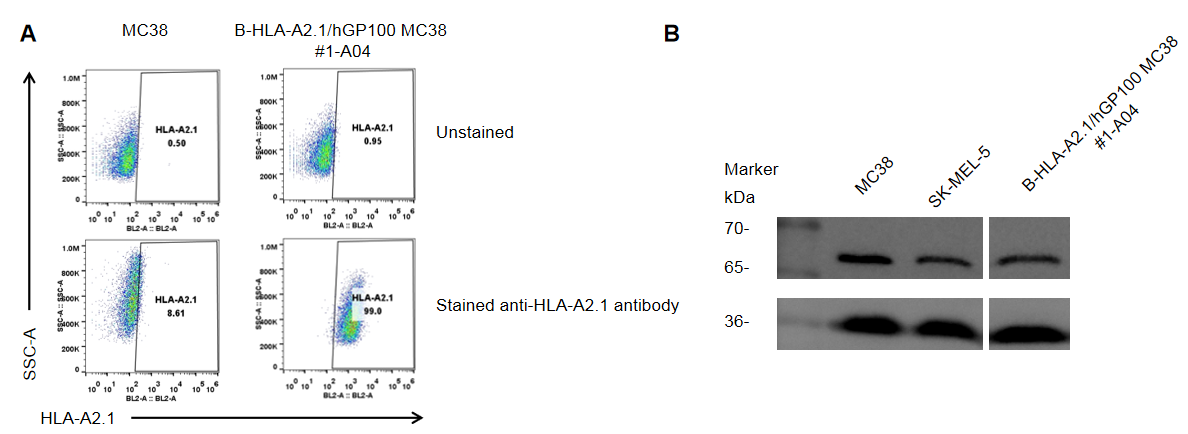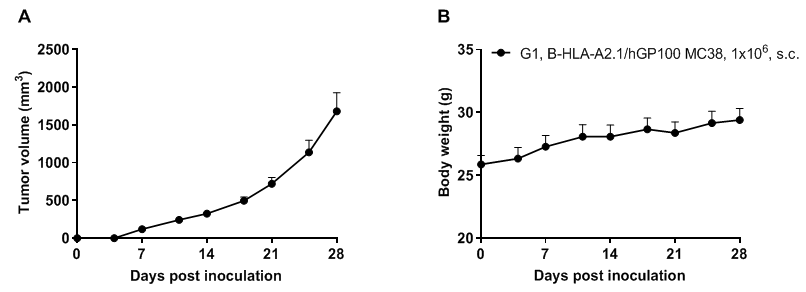B-HLA-A2.1/hGP100 MC38
|
Common name |
B-HLA-A2.1/hGP100 MC38 | Catalog number | 322400 |
| Aliases |
IMD43, AMYLD6, MHC1D4; HLAA; PMEL, ME20, P100, SILV, HMB45, ME20M
|
Disease | Colon carcinoma |
|
Organism |
Mouse |
Strain | C57BL/6 |
| Tissue types | Colon | Tissue | Colon |
- Origin: The MC38 cell line is derived from C57BL/6 murine colon adenocarcinoma cells. The cell line is a commonly used murine model for colorectal carcinoma.
- Background Information: HLA-A belongs to the HLA class I heavy chain paralogues. This class I molecule is a heterodimer consisting of a heavy chain and a light chain (beta-2 microglobulin). The heavy chain is anchored in the membrane. Class I molecules play a central role in the immune system by presenting peptides derived from the endoplasmic reticulum lumen so that they can be recognized by cytotoxic T cells. The GP100 gene encodes a melanocyte-specific type I transmembrane glycoprotein. The encoded protein is enriched in melanosomes, which are the melanin-producing organelles in melanocytes, and plays an essential role in the structural organization of premelanosomes. This protein is involved in generating internal matrix fibers that define the transition from Stage I to Stage II melanosomes. This protein undergoes a complex pattern of prosttranslational processing and modification that is essential to the proper functioning of the protein. A secreted form of this protein that is released by proteolytic ectodomain shedding may be used as a melanoma-specific serum marker. Alternate splicing results in multiple transcript variants.
- Gene targeting strategy: The B2M gene (Exon2 to Exon3) of mouse were replaced by the sequence encompassing the human B2M CDS, HLA-A*0201 gene that included leader sequence, α1 and α2 domains ligated to a fragment of the murine H-2Db gene containing the α3, transmembrane and cytoplasmic domains and GP100 CDS. Human HLA-A2.1 is highly expressed on the surface of B-HLA-A2.1/hGP100 MC38. Human GP100 is highly expressed on the surface of B-HLA-A2.1/hGP100 MC38 cells.
- Application: B-HLA-A2.1/hGP100 MC38 tumor models can be used for preclinical evaluation of cancer vaccines.

HLA-A2.1 and GP100 expression analysis in B-HLA-A2.1/hGP100 MC38 cells by flow cytometry, respectively. Single cell suspensions from wild-type MC38 and B-HLA-A2.1/hHER2 MC38 #5-G05 cultures were detected with species-specific anti-HLA-A2.1 antibody (Biolegend, 343306) and anti-human GP100 (Thermo Fisher, PA5-95605), respectively. Human HLA-A2.1 was detected on the surface of B-HLA-A2.1/hGP100 MC38 cells but not wild-type MC38 cells(A). Human GP100 was detected in the B-HLA-A2.1/hGP100 MC38 cells and wild-type MC38 cells as the antibody cross recognizes human GP100 and mouse GP100(B).

Subcutaneous tumor growth of B-HLA-A2.1/hGP100 MC38 cells. B-HLA-A2.1/hGP100 MC38 cells (1×106) were subcutaneously implanted into B-HLA-A2.1 mice (male, 7-week-old, n=6). Tumor volume and body weight were measured twice a week. (A) Average tumor volume. (B) Body weight. Volume was expressed in mm3 using the formula: V=0.5 × long diameter × short diameter2. Results indicate that B-HLA-A2.1/hGP100 MC38 cells were able to establish tumors in vivo and can be used for efficacy studies. Values are expressed as mean ± SEM.

HLA-A2.1 and GP100 expression evaluated in B-HLA-A2.1/hGP100 MC38 tumor cells by flow cytometry and western blot, respectively. B-HLA-A2.1/hGP100 MC38 cells were subcutaneously transplanted into B-HLA-A2.1 mice (male, 7-week-old, n=6). Upon conclusion of the experiment, tumor cells were harvested and assessed with species-specific anti-HLA-A2.1 antibody (Biolegend, 343306) and anti-human GP100 (Thermo Fisher, PA5-95605), respectively. Human HLA-A2.1 was highly expressed on the surface of tumor cells(A). Human GP100 was detected in the tumor cells(B). Therefore, B-HLA-A2.1/hGP100 MC38 cells can be used for in vivo efficacy studies evaluating cancer vaccines.









